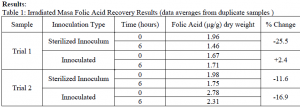Brandon Jahner and Dr. Michael Dunn, Nutrition, Dietetics, and Food Science
Introduction:
Pregnant women who consume the recommended micronutrient level of folic acid can reduce the incidence of newborn neural tube defects (NTD), like spina bifida and ancelephthy, by up to 70% (Yang et al., 2002). Hispanic women with the highest rates of NTD births, also have the lowest consumption of enriched grain products (Yang et al., 2002). In recent research conducted by Brigham Young University (BYU) faculty and students, corn tortillas were shown to be an effective vehicle for micronutrient fortification (Burton et al., 2008). Tortillas made with grains such as corn masa are considered an especially good micronutrient delivery medium because they are a Mexican staple food. However, 80% of the folic acid added to commercially produced, fortified corn masa was lost during commercial processing (Dunn and Serna-Saldivar, 2007).
Microbial degradation of folic acid during masa holding time before baking has been suggested as the primary cause of folic acid loss in commercial mills. A BYU study found thermal and pH-related degradation of folic acid was negligible. However, samples collected at a Mexican tortilla mill implementing the new fortification technology, indicated significant microbial growth in the freshly ground masa prior to baking (Chapman, 2009). Other studies also found both folic acid increases and degradation caused by lactic acid microorganisms in bread dough (Kariluoto et al., 2005). The present study aimed to observe microbial degradation of folic acid in fortified tortillas.
Method:
Fresh, nixtamalized masa (ground corn treated with calcium hydroxide) was collected from six commercial tortilla mills in Guadalajara, Mexico. Three individual lots of masa samples were purchased from each mill over three days and stored on ice for up to 30 hours before testing in sterile laboratory facilities. The first two lots of masa samples were plated in duplicate on APC, Yeast/Mold, and coliform 3M petrifilm, along with APC petrifilm treated for lactics enumeration using Tryp-Soy broth (0.1%) and incubated anaerobically. Samples were incubated to determine cfu/g for each tortilla mill’s lots. The third untested (lot 3) samples were stored on ice for 48 hours and transported to BYU (Provo, UT) for enumeration and folic acid assays.
Three Whirl-pak bags were filled with 75 g sterile-irradiated (>10.2 kGy) nixtamalized tortilla flour and 125 ml sterile water each trial. The first bag contained unfortified tortilla flour, the second and third bags both contained micronutrient premix currently to fortify masa in a limited number of Mexican mills. Twenty-gram portions of unfortified masa collected from lot 3 of mill one (previously reported in Chapman, 2009) were added to each of three Whirl-pak bags for Trial 1. One portion of inoculum masa was autoclaved for 15 minutes and cooled prior to adding into masa in bag 2. Whirlpak bags were stomached for 30 seconds on high speed and incubated at 56ºC. Twenty-five gram masa portions were collected from each innoculated masa bag at two hour intervals, for six hours starting at inoculation. Innoculated masa samples were sterile-transferred into small whirl-pak bags, flattened into one-centimeter thick disk and frozen at -50ºC, until folic acid and moisture analysis were conducted. Samples were kept under subdued lighting during the entire study from sample collection through analysis. Folic acid was determined using AACC method 86-47.01.
Microbial growth was enumerated at each two-hour sampling period, specifically tracking APC and lactics (cfu/g) in prepared inoculated masa. The times were limited at maximum six hours to account for the longest reasonable incubation time between grinding fresh masa and baking into tortillas. Mill two showed high lactics enumeration results (10^10 cfu/g) plated in Guadalajara. This mill’s masa sample was used for a duplicate inoculation of 3 new bags of irradiated masa following the previous procedure in Trial 1.
Results:
Conclusion:
Masa samples plated in Guadalajara showed low counts for coliform and yeast/mold; however, the lactic acid bacteria and APC counts were relatively high. The masa plated during the Provo section of the study showed considerable variation for the microbial growth. Folic acid degradation values were within ranges accepted by analytical variation, and not as dramatic compared to folic acid losses seen from previous testing at these mills. Concerns from inhomogeneous blending in the commercial vitamin premix to the dispersion within the masa flour could explain folic acid losses observed. Additionally, the mill’s (Trial 1) handling of the fresh masa had changed recently from holding in reusable five-gallon buckets to single use plastic bags observed most recently during this study.
Discussion:
BYU graduate student, Stephen Adolphson, who assisted with the ORCA research will repeat the microbial characterization of nixtamalized corn masa as a result of these findings. The multi-stage planning for travel and collecting samples from Mexico proved to be logistical challenge amidst travel security concerns. Additionally, the task of finding irradiation facilities and available microbiology labs abroad was also initially very constraining yet opened networking opportunities with US and international businesses to utilize their facilities in maximizing the ORCA funding. This study was successful for both refining methods in follow up research, as well as building partnerships for BYU Food Science research abroad.
Special thanks to: Curtis Park, Stephen Adolphson, Lifeline Foods, SADEX Corporation, and DSM Nutritionals (Guadalajara, Mexico)
References
- Burton KE, Steele FM, Jefferies L, Pike OA, Dunn ML. (2008) Effect of micronutrient fortification on nutritional and other properties of nixtamal tortillas. Cereal Chem 85(1):70-75.
- Dunn ML, Serna-Saldivar SO, Turner EH. (2007) Industrial approaches to micronutrient fortification of traditional nixtamal tortillas. Cereal Foods World 52(5):240-248.
- Chapman JS. 2009. Factors affecting folic acid stability in micronurient fortified corn tortillas.
- Yang Q, Carter HK, Mulinare J, Berry RJ, Friedman JM, Erickson JD. (2007) 2001-2002 Raceethnicity differences in folic acid intake in women of childbearing age in the United States after folic acid fortification: findings from the National Health and Nutrition Examination Survey 2001-2002. American Journal of Clinical Nutrition 85(5):1409-16.

